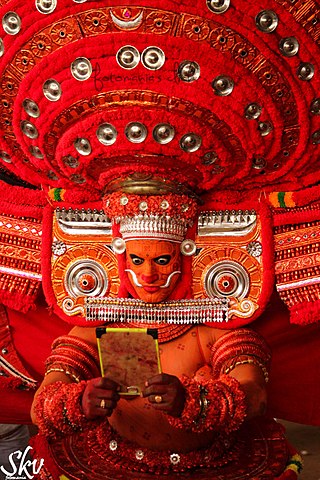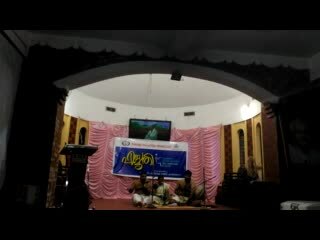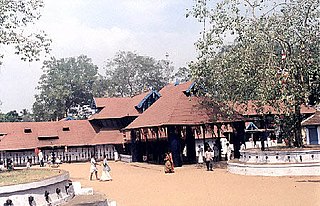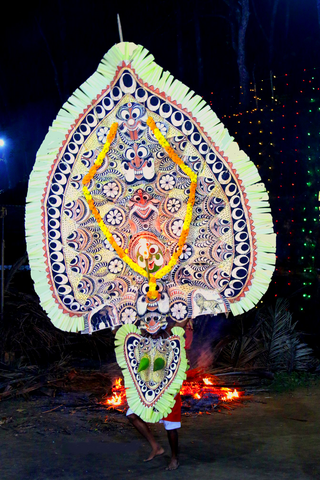
Ottan Thullal is a recite-and-dance art-form of Kerala, India. It was introduced in the eighteenth century by Kunchan Nambiar, one of the Prachina Kavithrayam. The folksy performance, often laced with humour intended at criticism of society, is accompanied by a mridangam and/or the handy idakka besides a pair of ilathalam cymbals.
Marthandam is a major trade centre in Kuzhithurai municipality across National Highway in the Kanyakumari district of Tamil Nadu, India. Formerly known as Thoduvetty, it was a portion of Kanyakumari district which was added to the state of Tamil Nadu on 1 November 1956.

Theyyam is a Hindu religious ritual practiced in northern Kerala and some parts of Karnataka. Theyyam is also known as Kaḷiyāṭṭaṁ or Tiṟa. Theyyam consists of traditions, rituals and customs associated with temples and sacred groves of Malabar. The people of the region consider Theyyam itself as a channel to a god and they thus seek blessings from Theyyam.
Azhakodi Devi Temple or Azhakodi Devi Mahakshethram is a Hindu temple located in Thiruthiyad, Kozhikode District, Kerala, South India. It is one of the famous Devi temples, situated hardly 1.5 km away from the Mofussil Bus stand and 2.5 km from the KSRTC Bus stand, the area still retains the beauty and charm of un-spoilt rural settings within the heart of the Kozhikode city. The temple and the Kalayana Mandapom are administered by the Malabar Devaswom Board.
Vavar, known reverently as Vavarswami, is a legendary figure from Kerala. He is traditionally believed to be a Muslim companion of the Hindu deity Ayyappan. The story of Vavar's association with Ayyappan is a significant aspect of the region's spiritual history. A shrine dedicated to Vavar is located at Sabarimala, one of the most prominent pilgrimage sites in Kerala. Additionally, a mosque dedicated to Vavar is situated in Erumely, opposite an Ayyappan temple.

Garudan Thookkam is a ritual art form performed in certain Kali temples in some Central Kerala districts in south India. The people who dress up as Garuda perform the dance. After the dance performance, the hang-designate dangle from a shaft hooking the skin on his back. In some places, the ritual is performed colorfully with Garudas taken in a procession on bullock carts or boats or hand pulled carts. It will be available in Devi temple during the festival of Meena bharani and Pathamudayam in Thiruvanchoor in Kottayam district.

Pulluvan Pattu is a form of serpent worship performed by both the lower castes and higher castes, in addition to serpent temples. The pulluvar of Kerala are closely connected to serpents. They consider the snake gods their presiding deities and perform sacrifices and sing songs.

Sarkaradevi Temple is one of the most important temples in South India. It is situated Chirayinkeezhu town in Thiruvananthapuram district. Tradition accords a remote antiquity to this temple. Its main deity is Bhadrakali. The Sarkaradevi Temple assumed a significant status for many reasons and rose to historical importance mainly with the introduction of the famous Kaliyoot festival by Anizham Thirunal Marthanda Varma, the Travancore sovereign, in 1748. The Sarkaradevi Temple have some basic attachment with Nakramcode Devi Temple which located in Avanavanchery, Attingal.

Karuppusamy, also known as Karuppu or Karuppannaswamy(Tamil: கருப்பண்ணசுவாமி Malayalam: കറുപ്പണ്ണസാമി ),(lit. 'Black God' or 'Black') is a Hindu god in Tamil Nadu, popular among the social groups of Tamil Nadu and Kerala and also Sri Lanka. He is one of 21 guardian deities of Ayyanar, and is one of 21 guardian deities in Dravidian folk religion.

Chettikulangara Sree Bhagavathi temple is one of the most renowned Hindu temples in Kerala. Main deity is Sree Bhadrakali. The temple is located at Chettikulangara in Mavelikkara taluk of Alappuzha district in the Indian state of Kerala. The temple is situated about 4 kilometres west of Mavelikkara town, 7 kilometres north of Kayamkulam city on SH6. Bhadrakali, is an incarnation of supreme mother Shakthi devi, born from the third eye of Lord Shiva, to kill the demon king Daruka. 'Bhadra' means good and 'Kali' means goddess of time. So Bhadrakali is worshipped for prosperity and salvation. Devi is considered as the creator, protector, destructor, nature, power and Kundalini shakthi. Chettikulangara is located near Kayamkulam city. Chettikulangara is in kayamkulam legislative assembly.

Sree Bhuvaneswary Temple, Valamchuzy is one of the oldest temples in Pathanamthitta, South India.
Theeyaattam also known as Theeyaattu (Tīyāttu) is a traditional temple dance form of Kerala.

Sree Kurumba Bhagavati Temple is a Hindu temple at Kodungallur, Thrissur District, Kerala state, India. It is dedicated to the goddess Bhadrakali, a form of Mahakali or simply Durga or Aadi Parashakthi or Bhuvaneshwari or Kannagi worshipped and significantly revered in Kerala. The goddess is known also by the names "Sri Kurumba"". This temple is the head of 64 Bhadrakali temples in Kerala. This Mahakali temple is one of the oldest functioning temples in India. The goddess of the temple represents the goddess in her fierce ('ugra') form, facing North, featuring eight hands with various attributes. One is holding the head of the demon king Daruka, another a sickle-shaped sword, next an anklet, another a bell, among others.

Padayani, also known Padeni, is a traditional folk dance and a ritual art from the central portion of the Indian state of Kerala. A ceremonial dance involving masks, it is an ancient ritual performed in Bhagavati temples. The dance is performed in honor of Bhadrakaali. Meaning, a 'row of warriors', Padayani is an art form that blends all music, dance, theatre, satire, facial masks, and paintings. It is part of worship of Bhadrakali and is staged in temples dedicated to the goddess from mid-December to mid-May. Padayani is unique to central Travancore, comprising the Pathanamthitta and Kottayam districts of Kerala. It is also performed in adjoining regions of Kollam, Alappuzha districts.

The MajorVellayani Devi Temple is a highly revered shrine in Kerala, India, dedicated to goddess Bhadrakali. The shrine is situated in Vellayani 1.5 km west of Vellayani junction, 12 km southeast of Thiruvananthapuram on the eastern bank of Vellayani Lake. The temple is under the management of Travancore Devaswom Board. The temple structure has a bronze roof with traditional art work and carries Dravidian architecture. The temple has eastern and northern towers called Gopurams with statues of different Gods sculptured in them. The Gopurams function as gateways through the walls that surround the temple complex.
Sarpam Thullal or Nagakalam Pattu, is a unique form of mystical ritual associated generally with ancestral temples or tharavadus predominantly in Valluvanadu region in state of Kerala. From ancient times many family houses in Kerala have special snake shrines called Kavu or Pambin Kavu where this exotic and spectacular ritual performance is associated to, it is generally conducted to appease the snake gods and thereby to bring prosperity to the family.
Azhakiyakavu Devi Temple is situated at Kallisseri in Chengannur taluk of Alappuzha district, Kerala, India. It is a Hindu temple dedicated to the goddess Bhadrakali and is one of the 30 temples in Central Travancore area where the ancient Dravidian ritualistic art form of Padayani is performed annually. The temple is 4 kilometres (2.5 mi) from Chengannur Railway Station and Bus Stand respectively.

Avanangattilkalari Sree Vishnumaya Temple is a Hindu temple at Peringottukara, Thrissur District, Kerala state, India. It is dedicated to the god Vishnumaya in Kerala. The god is known also by the names Chathan.

The Kanadikavu Shree Vishnumaya Kuttichathan Swami temple is an ancient Vishnumaya temple located 20 km southwest of Thrissur in Peringottukara, the cultural capital of Kerala, India.

Kodungallur Bharani festival is a yearly festival dedicated to the goddess Bhadrakali of Kodungallur Kurumba Bhagavathy temple held between the Bharani days of months Kumbham and Meenam of the Malayalam calendar. This period usually falls between the months of March and April in Roman calendar. This festival traditionally involves sacrifice of roosters, dance of oracles, lighting the traditional lamp, singing of libelous ballads (Bharanippattu) and smearing of the image of the goddess with sandalwood paste.













